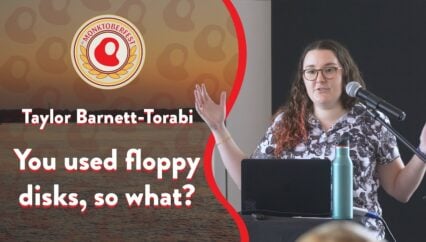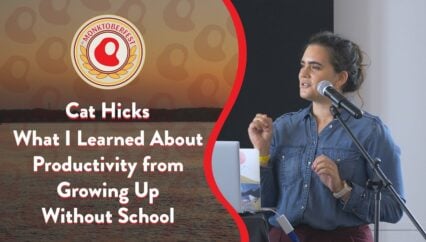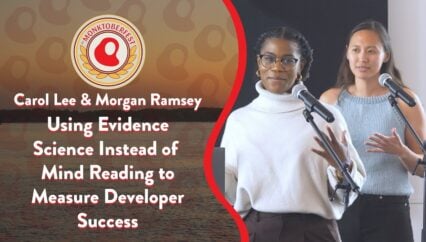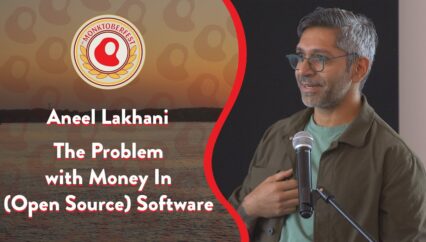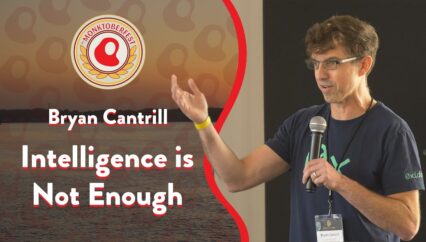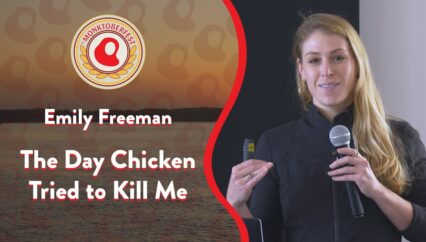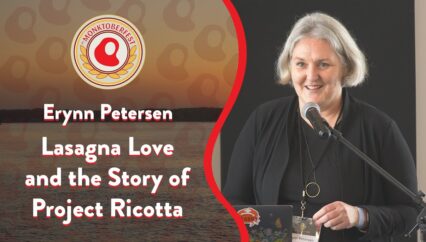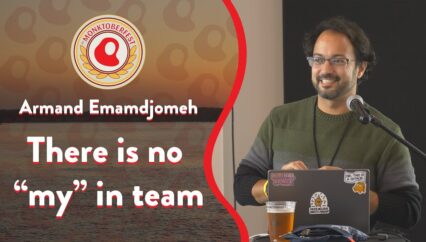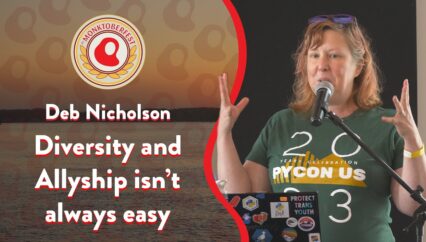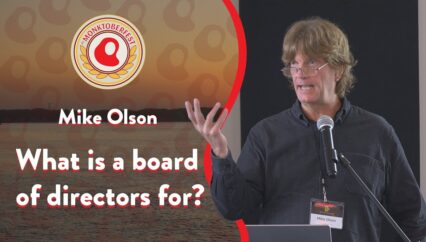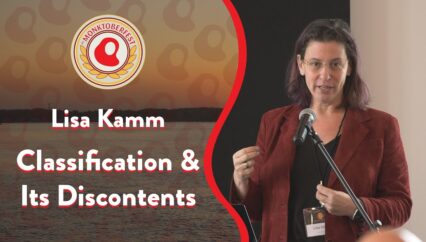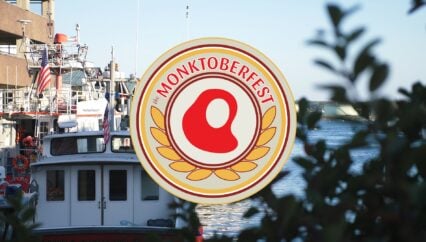This talk explores the concept of belonging and inclusion in team environments, drawing parallels between traditional Indigenous community greetings and modern workplace introductions. In Indigenous communities, questions like “Who’s ya mama?” or “Who’s ya people?” are standard when meeting someone new. Similarly, in professional settings, queries about previous employers or mutual acquaintances are common. These questions are typically aimed at establishing a connection or a sense of belonging with new colleagues. This talk includes insights from an Indigenous background to help listeners foster a sense of belonging. The focus is on creating inclusive, rather than exclusive, team dynamics. The most important takeaway from this talk are practical strategies for nurturing a welcoming and inclusive environment in whatever professional setting someone may find themself in.
Transcript
>> Hi, everyone, how are you? Woopwoop!?
[applause]
>> Hi, my name is Christina Pacheco, this is my first time being in Maine and my first time being at Monktoberfest. So thank you!
[applause]
Sorry, I had too much coffee, four shots of Espresso. But thank you to lily and Stephen for having me, and thank you all for just being so welcoming, I think there was a comment made earlier that said that somebody interacted with way more people than when if it’s a bigger conference. So thank you, pat yourselves on the back for networking and talking to little old me. Today I am going to talk about creating a sense of belonging through Indigenous culture.
And let me just jump right into it. You may be my cousin.
Who’s yo mama, and who’s your people? These are common phrased and questions that are asked in my Indigenous community. A similar theme of questioning may happen when you join a job or you meet somebody for the first time. They may ask what.company did you work for or did you know X from X organization. Normally we’re asking these questions because we’re trying to find some common ground and commonality with a person and get to know them and foster some culture with a colleague. So my goal today is to share my identity and culture as an Indigenous woman, to help you understand how you can create a sense of belonging in your workplace and to be inclusive, and not exclusive. I promise, I won’t brag about myself, maybe a little.
And we all know that company culture is important, right? We all agree? But I’m not talking pizza parties or mental health days that your boss gives you, tells you not to put it into PTO, but on a more granular level, team culture fosters a sense of belonging to help everybody drive healthy and positive relationships.
How many of you have ever heard of the Lumbee tribe in North Carolina? Oh! You may be my cousins.
We got it today after this. With over 55,000 members, it’s the biggest tribe east of the Mississippi River and 9th in the nation. The tribal community is located in North Carolina and it spans across four counties. The land is amongst pines, the swamps, and the dark waters of the. The ancestors are survivors of Tribal Nations, the Lumbee were recognized in 1885 by the state of North Carolina. I think it’s kind of funny how the government needed to tell us that we were real, even though I’m standing here before you, and in 1956, again, Congress recognized the Lumbee as an Indian tribe while denying our people federal recognition, and things that are associated with recognition, and I’m talking, you know, free health care and education, which I don’t get. But let’s explore what federal recognition means, exactly.
Federal recognition, and acknowledgment means that the United States Government recognizes a tribe or a nation to exist as a sovereign entity, but first one must understand a few terms and concepts. To understand the importance and meaning of federal recognition, the first is sovereignty.
It means the rights of a group to be self-governing. Nations that persist absolute sovereignty are completely independent of any other political power and examples of this are United States, Japan, Germany, but the Federal Government holds absolute sovereignty in the United States but it shares those powers with states and towns and municipalities. And this is called divided sovereignty and we know how the story goes. When Europeans first encountered American Indian tribes, they usually, but not always, treated them as political entities possessing absolute sovereignty.
The Federal Government also recognized ind tribes as fully independent sovereign powers. Basically we did what we wanted to do, and went where we want to go. However … I’m going to say a lot of howevers throughout this presentation. Somebody keep count.
As Americans pushed west with their manifesto, the Federal Government sought to limit tribes’ sovereign powers, because they wanted one thing: Gold.
In particular the United States wanted to prevent these tribes from making diplomatic alliances with foreign nations such as Spain and Great Britain. This was especially true following the War of 1812. The practice became embodied in federal law in 1832, when the United States Supreme Court Justice John Marshall issued his famous decision. The decision defined Indian tribes, and I quote, as domestic dependent nation the. In other words, they were no longer independent nations, possessing absolute sovereignty and by this decision the Federal Government reserved the right to control the external and diplomatic relations of tribes. In effect, they could only make alliances with the United States, and not other nations.
However, heh-heh-heh, this still left tribes with a large measure of sovereignty by allowing tribes to exist and let them regulate, you know, their internal affairs. When a tribe is fully recognized it has the right to establish agreements with the United States. In much the same way that the United States can do with Mexico, Canada and so forth. However … As Indian tribes may not make treatise or agreements with any other country except the United States.
So more than 100 years later, my tribe, the Lumbee tribe, my people, are still fighting for federal recognition. Hi, my name is Christina Pacheco, I’m a member of the Lumbee tribe of North Carolina. My parents are Pablo and Gail Garcia, and my familiar will is the descendens of the Pacheco and … family. How many of you have introduced yourselves as such, telling who your parents are? No, well in my tribal community, a lot of us announce ourselves with our last name or who our parents are, because it’s a way of task ourselves with our culture and our land.
The pictures on the screen are of me and my family, my dad. His shirt says the best dad ever. He actually bought that himself.
[laughter]
Me and my brother are like, nah, you know you’re great. This is my mom and my most prized possession, my 6 month old baby boy. His name is AJ. His brother, he is a cop in Charlotte, North Carolina, he also surfs, and some other pictures of me and ssorority,
I also published an article in our journal that I’ll talk about later. I also love to cook. I’m really big on Southern delicacies, like macaroni and cheese, fat back. Any of you like those, for
We’ve got to connect later.
Things that were a little different for me growing up, not in my tribal community. So I want to take to you and discuss some little pieces of history. How many of you have watched the Adams family and recognize this picture, right? It’s hilarious, I love Wednesday. She’s hilarious.
* so kill the Indian, save the man. It was a phrase that was used by Henry Pratt to describe the philosophy of assimilation. Pratt was a US officer who — he used the phrase in a speech in 1892. Pratt as philosophy was to strip Native Americans of their culture tradition and teach them the necessary skills to function in American society.
He prohibited any display of tribal traditions, cultures, clothing, dancing, you name it.
He also cut students’ hair, and he required them to speak English.
It was in Oklahoma territory where he was stationed as a soldier where he came up with the idea of having an Indian school and he began inviting locals to teach. And this is how the model for Indian education and boarding schools came about.
But these are not your typical schools. These schools often faced poor nutrition, infectious diseases, forced labor, incidents of physical, sexual and emotional abuse.
This is the kicker: From approximately 1863, to 1998, which was only 25 years ago, more than 150,000 Indigenous minors were taken from their families and placed in state boarding schools. According to a recent article in the Washington Post, many of you may have heard this in the news, the Department of the Interior reported that thousands and tens of thousands of native children died in the custody of federal Indian boarding schools and sadly they dug those bodies up.
Today, we see the continued erasure of Native American history and culture in the K-12 education system.
But why?
80% of all references to American Indians portray American Indians in a pre-1900s context, and I’m — I want you to think of my Indian education is a little more robust, because I lived in a tribal community, but for some of my peers, it looked very different and they were taught, I like to say, the big three.
Which was Christopher Columbus founded America and he helped everybody! No!
Christopher Columbus was a lost man. He didn’t know what he was looking for, and he came to destroy anything kind of in his path. And honestly the only Christopher I acknowledge is Wallace.
So big is small, right? Next, we have where the Indians got together and had a great big feast and called it Thanksgiving. No, there was actually a massacre.
Next up, we have the Trail of Tears, the Cherokee Indians got a full severance package with paid relocation. No, this was forced relocation and by Andrew Jackson.
There’s one that I did not include up here and I wasn’t going to include it, but I think I want to say it.
It’s the story of Pocahontas. And Pocahontas wasn’t her real name. Her real name was Sacajawea. Pocahontas was turned into a what? A Disney movie, of a girl who went with two white men to discover America along with her husband. But we all know that’s not how the story went.
The failure of the education system to teach the right side of history sticks, not only in K-12, but in college, as well.
So many questions.
Are you a real Indian? Are you full-blooded?
Where’s your feathers?
Do you speak Indian? Do you live in a teepee? And my favorite: Do you have running water?
I got these questions as soon as I stepped on campus of East Carolina University, yes, the best Carolina, but go you.
Greenville, NC, population 60% white and only 0.1% Native American. This is a joke, right? Compared to my tribal community, 42% of the people there were Native American.
This is my favorite movie, by the way. in the fall of 2012, I put on my hoodie, tossed on some yoga pants, put on my three-year-old Uggs, and I went to my freshman year, which was biochemistry. I wanted to be a nurse, but that didn’t work out. Along with four others, I was placed into a group. And we all know that college was the rite of passage, right you just had to do it. It was there in our group where I knew the first few words of my conversation that I did not belong. When I turned around and I looked at my 300-plus lecture class, there was no one there that sounded like me, looked like me or came from the place that I even came from. By the way, it was only a handful of us that went to college in my 90 graduating class in high school.
Even my college professors questioned my identity. And no, I did not have a single native professor in college.
I literally remember sitting in a cultural 101 class that I was required to take and we were going over the different cultures and identities of different students in the classroom.
And my teacher said: “Is there any Native Americans in the class?” I raised my hand, and she said, oh, Christina, come up and show us how you dance. I said, excuse me? I said you want me to … Or — I could not figure out what she was trying to ask.
As a queen of firsts in my family, I did not have a mentor who I could call up and say, hey, you know, my professor is just … Wow. I was the first to attend college. I was the first to go to secretary school, I was the first to land a good-paying job of the median income of $3 2,000 in my home town. I earned more than my parents combined. I was the first in my family not to do hard drugs. My mom studied for her G.E.D. at night when she was pregnant for me. She luckily was offered a job as a caretaker and then she finally landed a job as a nurse. And my stepdad, no, not my real father, but daddy issues for another day. He was a bit ambitious. Genius, right? He dropped out of school at 6th great. No, it was a means of survival to provide for his mom and dad in the mountains of Mexico at the sweet age of 16, he left America and he immigrated to the United States and he started picking oranges in Florida. My dad lived through several different decision and states and he actually learned English by watching Rambo and Godfather so yes, he cusses like a sailor.
I did not grow up in a house, I grew up in a trailer park, my school did not have IV or AV programs and honestly in college it was hard. Being away from tribal community literally made me sick. I my social and emotional health was failing, and I lost all sense of belonging.
And that’s why I’m kind of here today. I want to talk a little bit about the sense of belonging. And what it means.
What is it? It is a framework. It’s a subjective feeling of deep connection with social groups, physical places, and individual and collective experiences.
It’s a fundamental human need that predicts mental, physical, social, economic and behavioral outcomes.
What I’m going to be referencing in the next few slides comes from a study from the Australian psychological society. Sorry, I couldn’t find an American one. Go figure. But I’m going to be representing their framework in here. The first module in sense of belonging is competencies. Competencies are the keys to fitting and showing respect within a group. They help us act in line with social norms and embrace cultural values and treat our surroundings with care. Luckily most of us possess the social skills, involve social awareness, managing emotions, communication, both verbal and nonverbal, respecting social norms, and active listening, cultural skills, on the other hand, encompasses understanding of heritage, appreciating our environment, and embracing values. How many of you have ever heard of a talking circle? Participated in a talking circle?
So talking circles are kind of a staple in my community, I like to think. They have deep roots of traditions, in Indigenous communities, especially in the First Nations of Canada and Native American tribes in the US. The idea is pretty simple. You gather in a circle, you present a topic or a question. Sometimes it starts with prayer. And led by an elder and a person will get like a stick or an object to hold in their happened and the person who is holding that object is the only person allowed to speak. Nobody else is talking, no interruptions.
They encourage a deep listening and active listening and a reflection. They provide a way for people that might have a difficulty talking directly to each other during the circle when they have something to say.
>> And this is a powerful tool that I think can be implemented not only in the workplace, but in your own circle. When everybody gathers together and you have people who might not be more familiar with speaking out loud or being bold, giving them the power, giving them a kind of a placebo in their hands to speak and really encouraging them to be heard.
So kind of a CTA or a call to action is always be aware, have some active listening and have some mindfulness when you are interacting with people from different diverse backgrounds for the first time.
Let’s take it a little bit further than just ice breakers. Get to know you people.
The opportunities to belong: This is a second component.
Think of them as a chance to commit with people or hang out. I know for me when I was in college, there weren’t many opportunities presented before me to belong. Yes, I could commit with my peers, I could socialize with them. But where were people who kind of believed the same things I did. I know this may sound cliché, but encourage people around you and on your team, especially in your workplace, to join an Employee Resource Group. They’re out there. They’re not just there because they’re required to have by the company to have them through through some kind of diversity effort. They’re real people who are there who might share the same background as someone on your team.
Encourage people, especially people of color, to go out and to take heed and to really grasp any opportunity that they can. If you see an opportunity come across your email or across your desk, pass that along to somebody on your team who doesn’t look like you. Don’t pass it on to your college classmate, give someone else the opportunity. Because nine times out of ten, they’ve already received the same email.
Social media: Since Covid, interacting with people has been very hard, but I think your social media, when we find those connections and OK we’re meeting people for the first time, some of us already do it. What’s your LinkedIn, and what’s your Twitter? I encourage you to connect with those folks folks, and not just because you want a follow, really connect with them in social media and engage and share content and look at what they’re sharing because it can be a means of conversation in a workplace or other setting. Ooh, got five minutes.
Motivation: How many of you go into work and you just don’t want to be there today. It’s OK. Motivation, it’s the inner urge to desire is to connect with one another. Some things that you can do for a sense of belonging in terms of motivation is to help people find mentors. Again, this is not a cliché. Mentors are super-important. You’re putting that person in place of another person on the team who maybe has a higher rank or works somewhere else and it’s a means for them to connect even further and outside your team. Passion projects. Talk about those passion projects and about those purposeful things on your team, as well, to create a sense of motivation and also try and connect it with the work that you’re already doing with your job company. I know that’s better said than done but it can be done.
Some team-building activities and also some ice breakers with a purpose. Yes, you can do two truths and a lie, but why does it have to stop there? Take note of those things. Listen to people in the ice breakers when they’re talking about the past or they’re talking about the present. If they say they like ice cream, then when their birthday comes up, give them some ice cream. And lastly perceptions. Don’t assume. I think that is the biggest thing. Don’t assume that you know the person, don’t assume that you know their background, don’t assume that just because they’re Native Americans, they can dance. Don’t assume these things. I think it’s very important as leaders to educate yourself. Don’t put it on the person or the person from a diverse background on your team to educate you, because they’re already educating the world. So just make sure you’re educating yourself. You know who’s on your team, and if you don’t know, ask. Just ask. We expect you to fail. We expect you to say something stupid or dumb. It’s OK. You apologize and say, how do I really say that or what is the right word to say?
And lastly, people are not the spokesperson for their race, their culture, or their identity. They not even know who they are themselves, so just ask and don’t assume, and educate.
And lastly, I’m going to leave you with this. This is a book by Malinda May Lowery, she wrote this book called the Lumbee Indians, an American struggle. I’m going to read this excerpt that she put in her book. We do have our own National Anthem. And this is called Prod to be Lumbee.
Yes, I am proud to be a Lumbee Indian, yes, I am. When I grow up in this world, I’m gonna be just what I am. My mother and my father are proud of me. They want me to be free.
Free to be anything I want to be. Take a picture of this, instead of Lumbee Indians, putting your own culture, race, identity or how you identify and include your name. This sort of credo or affirmation or mantra, whenever you get in those moments or those rooms where you feel like you you don’t belong, because believe it or not, you may actually meet somebody who may be your cousin. Thank you.
[applause]
